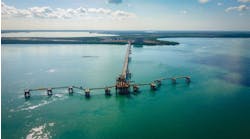David Shields, Contributing Editor
As Mexico’s oil output falls sharply with the decline of the supergiant Cantarell field in the Gulf of Mexico, the government of Felipe Calderon has decided to make major issues of exploring deepwater fields and of making state-run Petroleos Mexicanos (Pemex) a more efficient contractor. Calderon has sent a reform bill to congress that seeks legal amendments to allow Pemex to award performance contracts to drilling companies. However, while these contracts could be tempting for oil-service companies already established in Mexico and used to working with Pemex, they seem unlikely to crack open the door for IOCs to enter into Mexico.
In pushing for reforms, the government says deepwater is vital to the industry’s future, given the maturity and limited geological potential of onshore and offshore areas currently producing, and also points to the need to find ways of exploiting crossborder oil fields in the deepwater Perdido Fold Belt on the US-Mexico maritime boundary, where IOCs are already working in fields such as Great White, Trident, Baha, and Hammerhead on the US side. Seismic studies carried out by Pemex show that crossborder fields in Perdido likely exist.
To make its case, government officials say that if Mexico does not act, companies on the US side will drill and depressurize the fields, and pull the oil out from under the Mexicans’ feet through directional drilling, once a 10-year moratorium on drilling within 2.5 mi (4 km) on either side of the border expires in 2010. Other voices in Mexico call on the government to sit down with US officials from the Minerals Management Service to work on a unitization agreement for the boundary.
Pemex speculates there are over 29 Bbbl of unproven oil reserves in Mexico’s part of the deepwater GoM. So far, Pemex has practically no relevant deepwater experience, having only contracted the drilling of seven exploratory wells in waters of up to 1,000 m (3,281 ft) in southeastern Mexico. Moving into deepwater – especially into Perdido, where depths are roughly 2,500-3,000 m (8,200-10,000 ft) – would require joint ventures with IOCs and a much more lenient tax arrangement for Pemex.
However, Mexico’s traditionalist political establishment does not seem inclined to give Pemex the means to do this, as it would require changes to the constitutional prohibition on joint ventures and production sharing. It continues to be a taboo in Mexico to even think of sharing output or the revenues from oil sales with foreign companies. For that reason, bolder changes are not considered in the government’s reform proposal.
The government’s position is that Mexico must make major progress in deepwater projects now, if it is to aspire to maintain oil output and government revenues in the long term, given that the nation’s proven reserves to production ratio is now only 9.2 years. Pemex officials and people in government believe some progress can be made without constitutional amendments, if exploration is increased by awarding more attractive service contracts to third parties.
Performance contracts
The reform bill proposes exempting Pemex from contracting under Mexico’s public works law, thus giving it some freedom to develop its own bidding processes using performance contracts. The bill says these contracts “will be paid only in cash” and that remuneration on contracts could be “variable,” as goals could be set and modified as projects progress. Pemex would agree with contractors on incentives that “maximize effectiveness or success,” but would not pay for work that turns out to be “fruitless,” the bill says.
The contracts would give monetary incentives, as long as contractors provide good results or transfer technology, but there will be penalties if contractors do not comply with the terms, says Carlos Morales, who heads Pemex’s E&P division.
“The incentive is monetary and will come out of the budget. It will not depend on production from the well,” Morales says. “The proceeds from the sale of oil have to go to the finance ministry in duties or to Pemex in profits.”
The performance contracts would offer an additional payment worth between 15% and 20% of the value of the contract, not more, Morales says. Contractors, however, would be expected to take on operational and financial risk.
“We will want the contractor to provide the financing. This will help reduce the size of Pemex’s project-financing debt,” Morales says.
Penalizations will occur for poor performance, if the contractor does not have the rig or equipment in place on time or if he does not carry out the project to Pemex’s satisfaction.
It will probably be year-end before contract models are available for the market to evaluate. Moreover, it is not even clear whether congress will approve them. The reform bill likely will come up for a vote in August or September. However, it already seems likely that most international oil majors will not be interested, as they will not be allowed to share in production or profits nor book reserves.
If approved, the contracts may lead to some degree of political or legal controversy, in the same way that other Pemex contracts – the so-called “multiple services contracts” that allow private companies to develop natural gas fields in the onshore Burgos basin – have been challenged by lawmakers and have gone to court.
Floating rig market
For now, Pemex has proven its will to move into the floating rig market by awarding three major contracts for newbuild deepwater semisubmersible rigs capable of operating to 3,000 m (10,000 ft). The three contracts, each worth close to $950 million covering construction of the vessels to be rented for a five-year drilling term, were assigned last year to Mexican, British, and Norwegian companies, which will build units in Korea, Russia, and Singapore, respectively.
Mexico’s Industrial Perforadora de Campeche (IPC) secured a contract worth $975.7 million for theMuralla III rig, while Britain’s Sea Dragon Offshore took a similar deal for $959.2 million for its Sea Dragon Offshore I rig. The third contract went to Larsen Oil and Gas for Petrorig III at $942 million. All three were awarded through international public tenders.
The three rigs are to be delivered to Pemex in 2010 and will start drilling upon arrival. The day-rate for the each of the deals will be close to $500,000 per day. For Mexico’s IPC, the semisub contract is a major leap into the deep. It has been a contractor with Pemex for four decades, but never took on such a major commitment. ItsMuralla III will be built by Korea’s Daewoo Shipbuilding and Marine Engineering Co. and is scheduled for delivery in mid-2010.
TheSeaDragon Offshore I already is under construction at the Sevmash and Vyborg yards in Russia, with construction of the first hull to be completed this year. Larsen’s Petrorig III is set to be delivered in January 2010 from the Jurong shipyard in Singapore. It is a sixth generation semisubmersible and is being rented to Pemex at an estimated day rate of $485,000 for five years and a mobilization fee of $33 million.
Ongoing deepwater efforts
Meanwhile, Pemex began drilling on its seventh deepwater well, Tamil-1, in April 2008 and is renting Diamond Offshore’sOcean Voyager to do the work. Work on an eighth well, using a rig from Noble Drilling, is set to begin this year.
On the Tamil-1 well, in 2,190 ft (669 m) of water, Pemex is aiming to drill 10,280 ft (3,140 m) below the seabed. Since 2004, Pemex has drilled Chuktah-1 in 1,680 ft (513 m) of water, Nab-1, in 2,227 ft (680 m), Noxal-1 in 3,060 ft (934 m), Lacach-1 in 3,235 ft (988 m), Lalail-1 in 2,636 ft (805 m), and Chelem-1 in 2,653 ft (810 m). Gas was discovered in Noxal-1, Lacach-1, and Lalail-1, while extra-heavy oil was found in Nab-1. Only Lacach-1 is believed to be commercial.
Pemex needs to make faster progress in deepwater as it is the only long-term option for maintaining Mexico’s oil output, if one considers the time required for projects to mature, says Pemex’s Morales. Pemex has drilled seven deepwater wells over the past four years, while 167 such wells are drilled in the US Gulf each year, Morales notes.
“A key challenge will be to apply technologies for improving seismic images in areas of complex geology and subsaline plays. Overall, the sustainability of output will depend on successful exploration and on increasing the recovery factor on our fields,” according to Morales.
Morales defends the performance contract option.
“We need to be left to decide when we should and when we should not award such contracts, as we have to find and develop a large number of offshore fields in order to replace reserves,” he says, in apparent reference to the fact that Pemex currently needs authorization from the finance ministry to move ahead with projects.
The international average is for one out of every three offshore wells to succeed, so Pemex would have to drill 1,000 wells to get 300 producing wells in deepwater, he said. “With the five deepwater rigs Pemex is contracting for deepwater work, that would take us 66 years,” Morales says. Pemex has spent $626 million in investments in deepwater since 2002.
Pemex expects to drill only 13 exploratory wells in shallow water and two in deepwater this year, plus 58 development wells in the shallow water of Campeche Bay. By 2012, it hopes to be drilling 35 exploratory wells annually in shallow water and seven in deepwater, plus six development wells in deepwater and 55 in shallow water. The annual rig count could be ramped up, to the degree that useful reforms are passed, Morales says.
Reserves falling
Pemex has reported proven crude oil reserves of 12,187 Bbbl as of Jan. 1, 2008, an all-time low and a drop of 5.4% from a year earlier. As a sign of Pemex’s troubles and the need for reform, the government has made much of the fact that Mexico now has a proven reserves to production ratio of just 9.2 years.
Mexico’s proven oil reserves have declined steadily since 1982, reflecting intensive exploitation of oil fields and without sufficient investment in exploration. Investing in exploration was deemed almost unnecessary from 1980 to 2000 given the size of Mexico’s reserves at that time, but is now considered critical. Nevertheless, over 80% of Pemex’s E&P budget still funnels into production.
Mexico may have major reserves still to be discovered, but exploration results have been poor. Official figures show Mexico having reserves potential throughout 750,000 sq km (289,577 sq mi) of unexplored territory, but only 25% of that has been explored.
As Mexico looks towards the deepwater GoM, there has been much speculation about “prospective resources,” which are non-proven volumes of oil believed to exist in areas where no drilling has yet taken place. Mexico estimates that it has 53.8 Bbbl of “prospective resources” of which 29.5 billion lie in deepwater.
Output declining
Mexico’s crude oil output, which reached a peak of 3,455,000 b/d at the end of 2003, has fallen consistently below 3 MMb/d since October 2007. Energy ministry estimates suggest it could fall as low as 2.14 MMb/d a decade from now, as major fields decline. Output from Cantarell stood at 1.215 MMb/d in the first quarter of 2008, 925,000 b/d lower than its peak level of 2.14 MMb/d in December 2003. Cantarell now accounts for only 41% of Mexico’s crude oil production, compared to 63% four years ago.
The decline has been offset partly by significant increases at other offshore oil fields in Campeche Bay. Official figures show output from the heavy oil Ku-Maloob-Zaap (KMZ) complex has increased by about 300,000 b/d over the past four years, while output has jumped by roughly 200,000 b/d from a number of small fields on the Tabasco Littoral, known as the Offshore Light Crude project. KMZ produced 666,000 b/d in 1Q 2008, up 40.7% from 473,000 b/d a year earlier, and now accounts for 22% of Mexico’s total production. KMZ is expected to reach a peak of 800,000 b/d in 2009, before declining sharply. Output from the Tabasco Littoral fields is already believed to be peaking.






